
95% of researchers rate our articles as excellent or good
Learn more about the work of our research integrity team to safeguard the quality of each article we publish.
Find out more
ORIGINAL RESEARCH article
Front. Immunol. , 12 April 2021
Sec. Immunological Tolerance and Regulation
Volume 12 - 2021 | https://doi.org/10.3389/fimmu.2021.653198
This article is part of the Research Topic Characterization, Functions, and Roles of Antigen-Specific Regulatory T Cells in Health and Disease View all 18 articles
Interleukin (IL)-35-secreting B (IL-35+B) cells are critical regulators in autoimmune and infectious diseases and exert suppressive functions in parallel with IL-10-producing B (B10) cells. However, the role of IL-35+B cells in persistent hepatitis B virus (HBV) infection remains unclear. To elucidate the role of IL-35+B cells in the progress of chronic HBV infection, we determined the frequency of IL-35+B cells and their relationship with the classical human regulatory B cell (Breg) subsets, namely, CD19+CD24hiCD38hi and CD19+CD24hiCD27+. Then, the regulatory effect and mechanism of Bregs on effector T cells were investigated in vitro. Here, we found that compared with healthy controls, the frequency of IL-35+B cells was increased in patients with chronic HBV infection and was enriched in human classical Breg subset CD19+CD24hiCD38hi B cells. Moderate correlation was observed between the frequency of IL-35+B cells and alanine aminotransferase levels (Spearman r = 0.401), but only mild correlation was noted between the frequency of IL-35+B cells and HBV DNA level (Spearman r = 0.314). The frequency of IL-35+B cells was negatively correlated with interferon-γ (IFN-γ)-producing CD4+ and CD8+ cells but positively correlated with IL-4-producing T cells. Bregs dysregulated T cell function through an IL-35-dependent mechanism and depended on cell-to-cell contact. In conclusion, IL-35+ B cell was enriched in CD19+CD24hiCD38hi B cell subset during persistent HBV infection and Breg cells exerted dysregulation in T cell function through IL-35 dependent mechanism and depend on cell-to-cell contact.
Clinical Trial Registration: www.ClinicalTrials.gov, identifier NCT03734783.
Chronic hepatitis B virus (HBV) infection is a major global health concern that is correlated with the occurrence of liver cirrhosis and hepatocellular carcinoma and affects more than 200 million patients worldwide (1). Host acquired antiviral immunity, especially T cell immunity, is vital in HBV clearance during acute and chronic HBV infection, however, once a chronic HBV infection is established, viral-specific T cell immunity is manifested as functional imbalance or exhaustion, and the mechanism is not yet fully understood (2–6). Immune suppressor cells such as CD4+CD25highFoxP3+ regulatory T cells (Tregs) (4), costimulatory factors such programmed death factor 1 pathway (7, 8), and Treg/Th17 imbalance (9, 10) are important in the exhaustion of T cell immune function during chronic HBV infection.
Regulatory B cells (Bregs), newly identified regulatory cells, exert immunoregulatory roles in the course of infectious diseases (11, 12), autoimmune diseases (13, 14), and cancer (15, 16) by secreting interleukin (IL)-10, transforming growth factor-β1 (TGF-β1), IL-35, and other inhibitory cytokines. Das et al. (17) studied the role of Bregs in persistent HBV infection and found that IL-10-producing B (B10) cells are enriched in patients with chronic hepatitis B (CHB) and the frequency of B10 cells is correlated temporally with hepatic flares. In another study, Gong et al. (18) simply defined Bregs as CD19+IL-10+ cells and demonstrated that these Bregs have similar immune regulatory function to Tregs during chronic HBV infection.
IL-35 (p35/Ebi3), an anti-inflammatory cytokine of the IL-12 family, which is highly expressed in CHB patients and plays an important role in the inhibition of cellular immune response (19–21), is another major effector cytokine of Bregs. Shen et al. (22) had demonstrated that IL-35-secreting B (IL-35+B) cells are another critical regulator during autoimmune and infectious diseases and exert suppressive functions in parallel with B10 cells. However, the role of IL-35+B cells in CHB remains unclear. In the present study, we aimed (1) to examine the frequency of IL-35+B cells in total peripheral blood B cells of CHB patients, (2) to determine the frequency of IL-35+B cells in two humans classical Breg subsets in CHB, (3) to investigate whether Bregs regulated T cell function through IL-35 pathway, and (4) to explore the possible mechanism of Bregs on effector T cells.
All individuals were recruited according to the protocol that was approved by the clinical Ethics Committees of Shanghai Changhai Hospital (CHEC2017-118) and registered on Clinicaltrials.gov (NCT03734783). The study was conducted between July 2017 and November 2019. Written informed consent was obtained from all participants.
Patients with CHB were all sero-positive for hepatitis B surface antigen (HBsAg) for at least 6 months and negative for other hepatotropic viruses, such as hepatitis D virus (HDV), hepatitis C virus (HCV), hepatitis E virus, hepatitis A virus, and human immunodeficiency virus 1/2. Healthy controls (HCs) did not have any previous history and current evidence of liver disease. Serum alanine aminotransferase (ALT) values were normal, and HBsAg and other hepatitis virus markers were negative. Furthermore, all participants were sero-negative for markers such as ceruloplasmin, anti-nuclear antibodies and anti-mitochondrial antibodies for co-existent autoimmune and metabolic liver diseases.
Peripheral blood mononuclear cells (PBMCs) were isolated using lymphocyte separation medium (Ficoll-Hypaque density gradient, Axis-shield, Germany). The antibodies and fluorochromes used in this work are shown in Table S1.
For Breg subset and B10 or IL-35+B cell detection, PBMCs (2 × 106) were stimulated with CD40L (5 µg/mL, Purified Anti-Human CD154 (CD40L), Tonbo Biosciences, USA) plus CpG-ODN (1.5 µM, TLR9 Agonist-Stimulatory Class B tlrl-2006, InvivoGen) and lipopolysaccharide (LPS, 1 µg/mL, eBioscience) for 48 h. Furthermore, cells were activated for another 4 h at 37°C in 5% CO2 with 50 ng/mL phorbol myristate acetate, 1 mmol/L ionomycin (both from Sigma, St. Louis, MO, USA), and 10 mg/mL brefeldin A (Tocris Cookson, Bristol, UK) in complete RPMI-1640 (Invitrogen, Carlsbad, CA, USA) supplemented with 10% heat-inactivated fetal bovine serum (Gibco, Grand Island, NY, USA). The cells were then collected and washed with PBS once and stained for surface markers. Then, they were permeabilized with Perm/Fix solution (Cytofix/Cytoperm™, BD biosciences) and stained intracellularly with specific fluorescent conjugated anti-human IL-10, eBi3/IL-12/IL-35p35 (IL-35). For B cell subsets, we analyzed two classical Breg subsets: CD24hiCD38hi, CD24hiCD27+, the total IL-10 secreting B cells and IL-35 secreting B cells, which were all gated on CD19+ cells (Figure S1B). We also determined the frequency of IL-35 producing Breg: CD24hiCD38hiIL-35+, CD24hiCD27+IL-35+, and IL-10 secreting Breg: CD24hiCD38hiIL-10+, CD24hiCD27+IL-10+, frequency was determined into CD24hiCD38hi and CD24hiCD27+ gates, respectively (Figure S1).
For T cell subsets detection, freshly isolated PBMCs (2 × 106) were stimulated for 5 h with 50 ng/mL phorbol myristate acetate,1 mmol/L ionomycin (both from Sigma, St. Louis, MO, USA), and 10 mg/mL brefeldin A (Tocris Cookson, Bristol, UK) in complete RPMI-1640 (Invitrogen, Carlsbad, CA, USA) supplemented with 10% heat-inactivated fetal bovine serum (Gibco, Grand Island, NY, USA). Upon harvest, cells were first stained with surface markers (CD3-APC-Cy7-A, CD4-FITC-A, and CD8-PerCP-Cy5-5-A) and then intracellularly stained with IL-17-APC-A, IFN-γPE-Cy7-A, and IL-4-PE-A. All these T cell subsets were gated on PBMC cells (Figure S2).
Flow cytometry was performed using a FACSCalibur (Becton Dickinson, San Jose, CA). FACS data were analyzed using CellQuest software (Becton Dickinson Rutherford, NJ).
Serum concentrations of inflammatory cytokines, including IL-4, IL-17A, IL-21, and interferon-γ (IFN-γ), were measured using commercially available Luminex MAP kits (ProcartaPlex 5 plex, 1 plate 5-plex, eBioscience) in accordance with the manufacturer’s instructions. Samples were two times diluted with 1×universal assay buffer and tested in triplicate.
Serum and PBMC culture supernatant concentrations of IL-35 and IL-10 were measured by using commercially available ELISA kits (XpressBio, USA; Proteintech, USA) in accordance with the manufacturers’ instructions. All samples were not diluted and assessed in triplicate.
Purified B cells isolated from PBMC using anti-human CD19 microbeads (Miltenyi Biotec, Bergisch Gladbach, Germany) were treated with CpG/CD40L/LPS with or without HBVcore (1-183 a.a) (ProSpec, USA) for 48 h. After stimulation, B cells were washed with PBS twice and then co-cultured with autologous CD19-depleted PBMCs (50,000 cells) at the ratio of 2:1 in anti-CD3/CD28 (working concentration of anti-CD3 and anti-CD28 was 10μg/ml and 2μg/ml respectively, Tonbo Biosciences, San Diego, CA)-coated 96-well plate in complete RPMI-1640 (Invitrogen, Carlsbad, CA, United States) supplemented with 10% heat-inactivated fetal bovine serum (Gibco,Grand Island, NY, United States) for another 48 h. After 48 h of co-culture, the frequency of IL-4-, IFN-γ-, and IL-17A-secreting T cells was evaluated by flow cytometry.
Transwells of 0.4 µm pore size were used (Millicell, Merck Millipore, Billerica, MA, USA). CD19-depleted PBMCs (50,000 cells) were added to the lower chambers of 24-well plates and subsequently stimulated with anti-CD3/anti-CD28 as described above, whereas non-treated or stimulated B cells (100,000) were added to the upper chambers in the transwells. As controls for the transwell assay, CD19-depleted PBMCs (50,000 cells) and stimulated B cells (100,000 cells) were also co-cultured in the same plate in the lower chambers with anti-CD3/anti-CD28. After 48 h of co-culture, CD19-depleted PBMCs were gathered, and the frequency of IFN-γ-secreting T cells was tested by flow cytometry. For cytokine blocking study, anti-IL-12/IL-35 p35 (1 µg/mL, R&D Systems) and anti-IL-10 (5 µg/mL, Invitrogen) were added to the co-culture system to investigate the potential mechanism of Breg on T cells.
Serum HBV DNA levels were quantified using fluorescent quantitative PCR with commercially available kits (Sansure Biotech, China). The detection range was 1 × 102 to 5 × 108 IU/mL.
The levels of HBsAg, HBeAg, anti-HBs, anti-HBc, anti-HBe, anti-HCV, anti-HDV, anti-HGV, anti-HIV-1, and anti-HIV-2 were measured using commercially available kits (Abbott Laboratories, North Chicago, IL) in our clinical laboratory. The dynamic range of serum HBsAg was 0.05–250 IU/mL. The samples were diluted to 1:500 or 1:1000 using the ARCHITECT HBsAg Manual Diluent (Abbott Diagnostics) if >250 IU/mL.
Normally distributed continuous quantitative data were expressed as the mean ± SEM, and non-normally distributed continuous quantitative data were expressed as median (interquartile range,IQR). The non-parametric Mann–Whitney U test was used to evaluate the differences between two independent samples, and the non-parametric Kruskal–Wallis ANOVA test was used to evaluate the differences in more than two groups. The non-parametric Friedman ANOVA test was used to evaluate effector T cell proportions in co-culture experiments. The statistical correlation between variables was calculated by Spearman rank correlation analysis. P-value < 0.05 was considered statistically significant. All analyses were performed using SPSS software (version 21.0.0; Chicago, IL). The graph was made using GraphPad Prism 5 (San Diego, CA, USA).
The clinical and biochemical characteristics of the studied patients are listed in Table 1. All 68 CHB patients were treatment-naïve at enrollment. Approximately 57.35% (39/68) of patients had ALT levels greater than the upper limit of normal (ULN) at enrollment, and higher proportions of patients in the abnormal ALT group were HBeAg positive compared with those in the normal ALT group. Similarly, HBeAg-positive patients at enrollment had higher median ALT levels than HBeAg-negative patients. Twenty-six age- and gender-matched HCs were enrolled.
To determine the role of IL-35 in persistent HBV infection, we first determined the serum IL-35 concentration in 68 patients with persistent HBV infection. Compared with HCs, CHB patients had significantly increased serum IL-35 levels. Stratified analysis found that the serum IL-35 levels were significantly increased in 39 patients with liver flare (Figure 1A); patients with active viral replication, including 39 HBeAg+ CHB patients; and 49 patients with viral load more than 2E4 IU/mL (Figures 1A, B).
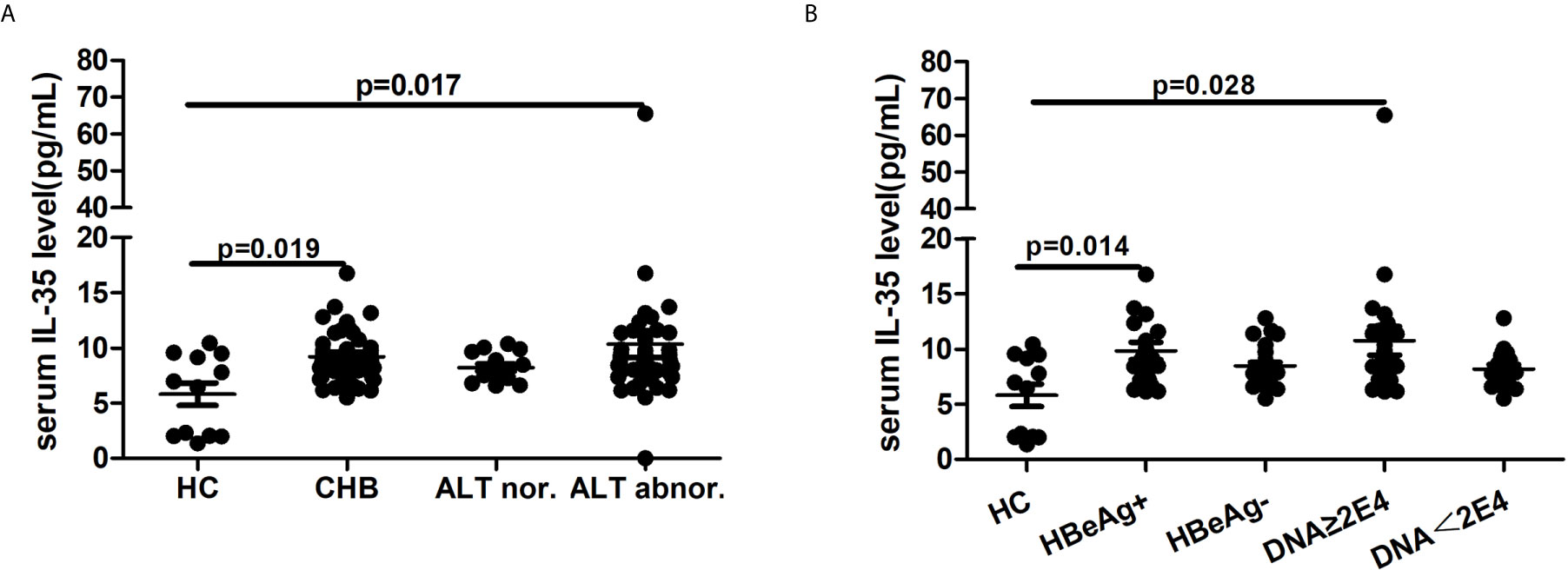
Figure 1 Serum IL-35 level in patients with chronic hepatitis B. 68 CHB patients were enrolled in this assay. Non-parametric Mann-Whitney U and Non-parametric Kruskal-Wallis ANOVA test were used to evaluate the differences between two groups and among groups more than two, respectively. P value<0.05 was considered statistically significant. (A) Serum IL-35 level in patients with different degree liver inflammation; (B) Serum IL-35 level in patients with different viral replication level. Data are shown as mean ± s.e.m.
Breg response was defined by functional cytokines (23), and many researches have demonstrated that IL-35+B cells play a suppressive regulatory role in autoimmune and infectious diseases (22–24). However, the role of IL-35+B cells in chronic HBV infection is still unclear. To evaluate the role of circulating mononuclear cells in IL-35 secretion in persistent HBV infection, we quantified the frequency of IL-35+B cells in total B cells in 35 patients with chronic HBV infection. Compared with that in HCs, the frequency of both IL-35+B cells and IL-10-secreting B (B10) cells in total B cells in patients with chronic HBV infection was not increased significantly. (Figure 2A).
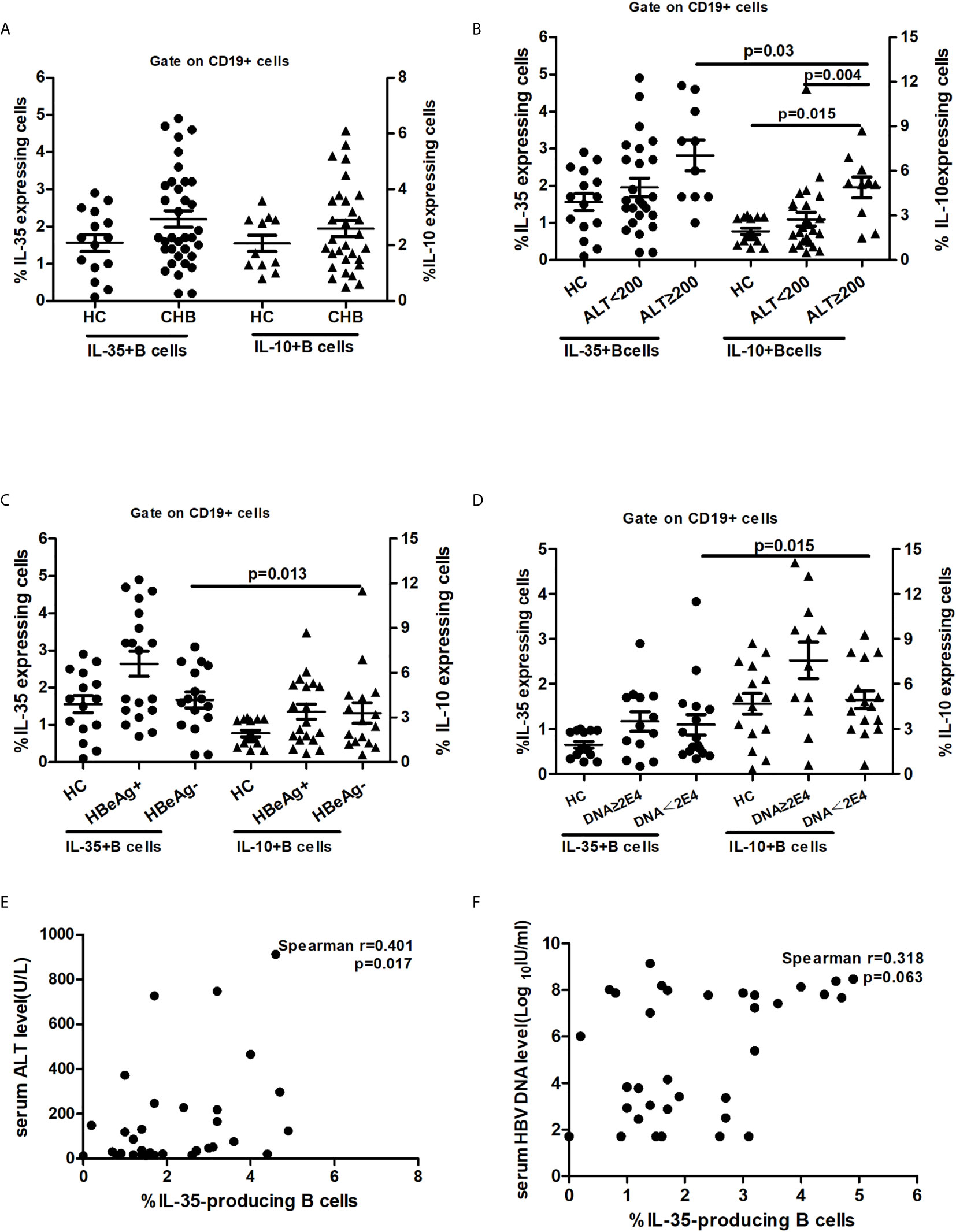
Figure 2 IL-35-producing B cells in patients with chronic hepatitis B. 35 CHB patients (25 of them with ALT ≤200, 17 of them with HBeAg positive and 13 of them with HBV DNA≥2E4) and 15 HCs were enrolled in this assay. Difference between two groups and among groups more than two was test by Non-parametric Mann-Whitney U test and Non-parametric Kruskal-Wallis ANOVA test, respectively. Statistical correlation between variables was calculated by the Spearman rank correlation analysis. P value<0.05 was considered statistically significant. (A) IL-35-producing B cell was enriched and in parallel with IL-10-producing B cells in patients with chronic hepatitis B; (B) Patients with chronic HBV infection had high frequency of IL-35+B and IL-10-producing B cells cells in the peripheral blood; (C) Frequency of IL-35-producing B cells and IL-10-producing B cells in patients with different HBeAg status; (D) Frequency of IL-35-producing B cells and IL-10-producing B cells in patients with different viral load; (E) IL-35-producing B cells were moderately correlated with ALT level; (F) IL-35-producing B cells were mildly correlated with serum viral load.
To analyze the relationship between IL-35+B cells and liver inflammation degree and viral replication level, we divided the treatment-naïve patients into two groups according to the ALT levels: patients with high ALT levels (ALT ≥ 200 U/L, n=25) and patients with low ALT levels (ALT < 200 U/L, n=10). Then, we also divided the patients into two groups according to HBeAg status and HBV DNA levels: patients with high virus replication (HBeAg positive, n=19; or HBV DNA ≥ 2E4 IU/mL, n=17) and patients with low virus replication (HBeAg negative, n=16 or HBV DNA < 2E4 IU/mL, n=18). Compared with HCs and patients with low ALT levels, patients with high ALT levels had the highest frequency of IL-35+B and B10 cells (Figure 2B). Among patients with different HBeAg status or viral loads and HCs, no significant difference was found in the frequency of IL-35+B cells (Figures 2C, D) in the peripheral blood total B cells. However, in patients with low viral replication, the frequency of B10 cells was higher than that of IL-35+B cells (Figures 2C, D). According to Spearman correlation analysis, a moderate correlation was observed between the frequency of IL-35+B cells and ALT levels (Figure 2E), but only mild correlation was found between the frequency of IL-35+B cells and HBV DNA levels (Figure 2F). The frequency of B10 cells was only moderately correlated with serum ALT levels in these patients (Figure S3).
To quantify the frequency of various Breg subsets, the PBMCs of 33 CHB patients (17 HBeAg-positive patients and 16 patients in the abnormal ALT group) and 11 HCs were isolated and stimulated with CpG plus CD40L and LPS in vitro for 48 h, which was proved to potently induce Breg differentiation (22, 25). Then, the frequency of classical human Breg subsets CD19+CD24hiCD38hi and CD19+CD24hiCD27+ was quantified using flow cytometry. Compared with HCs, the frequency of CD19+CD24hiCD38hi (19.76% ± 3.64% vs. 8.43% ± 3.46%) and CD19+CD24hiCD27+ (11.42% ± 2.37% vs. 6.28% ± 2.18%) increased in patients with CHB (Figure 3A). Further stratified analysis of the frequency of Breg subsets in patients according to HBV replication and liver inflammation degree showed that patients with active liver inflammation (ALT ≥ 2*ULN) and virus replication (HBeAg positive) had higher frequency of Breg subsets, and in these patients, the Breg subset was dominated by CD19+CD24hiCD38hi (Figures 3B, C).
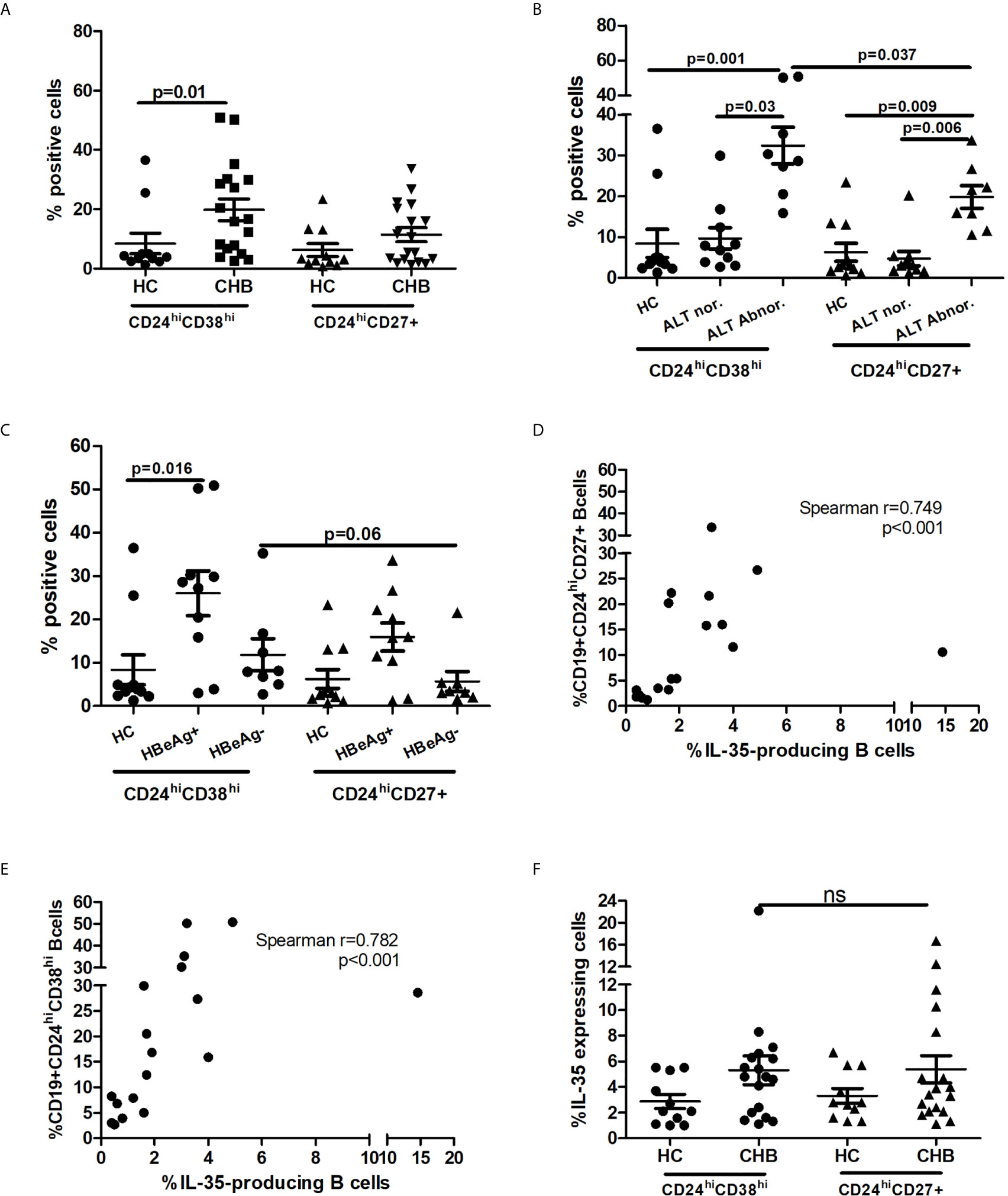
Figure 3 Breg subsets in CHB patients and healthy controls (HCs). Two human classical Breg subsets was gated on CD19+ cell. (A) Frequency of CD19+CD24hiCD38hi or CD19+ CD24hiCD27+ Breg subsets in total CHB patients and HCs; (B) Frequency of CD19+CD24hiCD38hi or CD19+ CD24hiCD27+ Breg subset in CHB patients according to different liver inflammation; (C) Frequency of CD19+CD24hiCD38hi or CD19+ CD24hiCD27+ Breg subsets in CHB patients according to different virus replication level; (D) The frequency of IL-35-producing B cells was strongly correlated with the frequency of CD19+ CD24hiCD27+ Breg subset; (E) The frequency of IL-35-producing B cells was strongly correlated with the frequency of CD19+CD24hiCD38hi Breg subset; (F) Higher frequency of IL-35-positive Breg subset in patients with chronic HBV infection. Difference between two groups and among groups more than two was test by Non-parametric Mann-Whitney U test and Non-parametric Kruskal-Wallis ANOVA test, respectively. Statistical correlation between variables was calculated by the Spearman rank correlation analysis. P value<0.05 was considered statistically significant. ns, no significant difference.
As IL-35 is one of the markers of phenotypic changes in B cells, we analyzed the relationship of the frequency of IL-35+B cells with human classical Breg subsets during persistent HBV infection. As shown in Figures 3D, E, the frequency of IL-35+B cells was strongly correlated with that of two classical human Breg subsets during persistent HBV infection (Spearman r = 0.749 and 0.782, P < 0.001). Furthermore, we found that patients with persistent HBV infection had higher frequency of IL-35-positive Breg subsets compared with HCs, but no difference was observed between the two classical Bregs (Figure 3F).
The main function of Bregs is to regulate the differentiation of Th cells and exert suppressive function on T cell proliferation through their effector factors, such as IL-10, IL-35, and TGF-β1. To evaluate the function of IL-35+B cells during persistent HBV infection, the frequency of IL-35+B cells and homologous effector T cell subsets was measured, and the correlation of IL-35+B cells with various T cell subtypes in CHB patients was analyzed using Spearman’s rank correlation analysis. We found that the frequency of IL-35+B cells was negatively correlated with that of IFN-γ-producing CD4+ and CD8+ cells, but positively correlated with that of IL-4-producing T cells (Table 2). However, a weaker correlation was found between serum IL-35 levels and different T cell effector cytokines (Table S2).
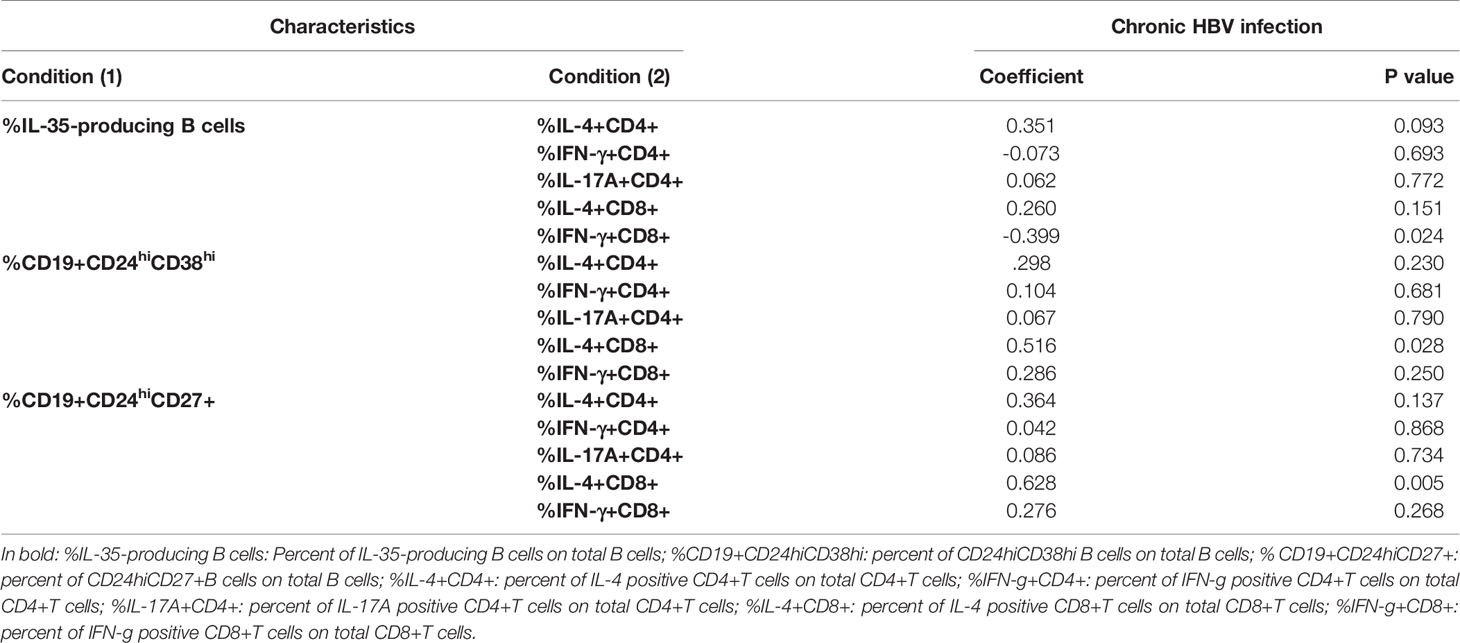
Table 2 Correlation between frequency of IL-35-producting B cells or Bregs with various T cell subsets.
To determine the suppressive effect of Bregs on T cells, B cells isolated from PBMCs using anti-CD19 microbeads were stimulated with CpG/CD40L/LPS with or without HBVcore peptide for two days. Then, autologous CD19-depleted PBMCs were co-cultured with HBV-exposed B cells or stimulated B cells and subsequently activated with anti-CD3/anti-CD28 for another 48 h. Because of the importance of Th1/Th2 imbalance in CHB disease progression, we aimed to determine the regulatory effect of Bregs on IL-4- and IFN-γ-producing T cells. As shown in Figures 4A–E, ECs were stimulated significantly in vitro by anti-CD3/CD28, and Bregs significantly decreased the frequency of IFN-γ-producing CD4+ and CD8+ T cells (Figures 4A, D). However, the frequency of IL-4-producing T cells and IL-17-producing T cells were not significantly affected by Bregs (Figures 4B, C, E).
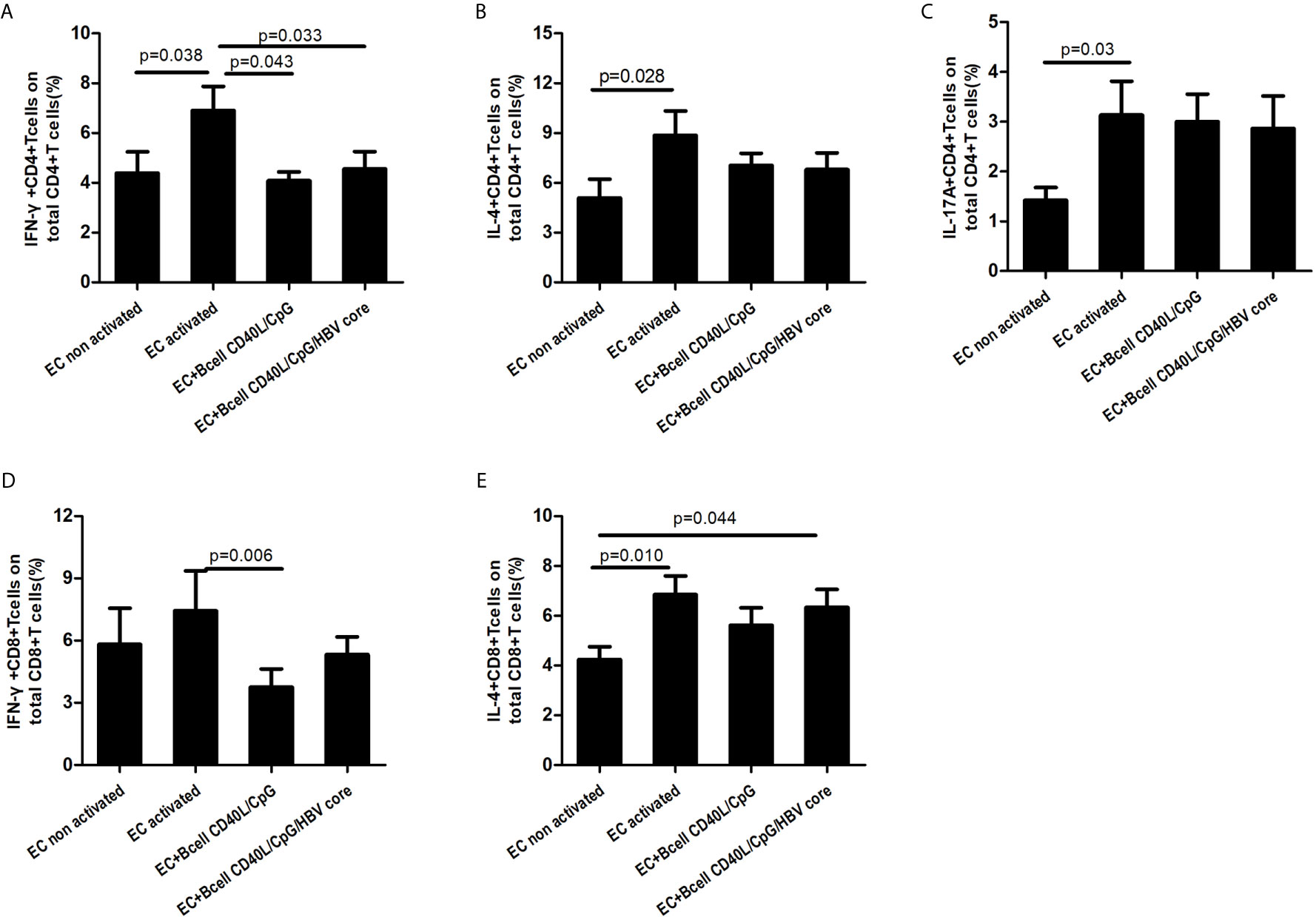
Figure 4 Suppression effect on effector cells (ECs). B cells were isolated from PBMC using CD19+ microbead and stimulated with CD40L/CpG/LPS with or without HBVcore peptide. Stimulated B cells were then co-cultured with autologous CD19-depleted PBMCs at the ratio of 2:1 in anti-CD3/CD28 coated plate for 48hours. As a control, CD19-depleted PBMCs were also cultured alone without B cells (CD19-depleted PBMCs non-activated and CD19-depleted PBMCs activated). (A) Suppression effect on IFN-ɤ-producing CD4+T cells; (B) Suppression on IL-4-producing CD4+T cells; (C) Suppression effect on IL-17A-producing CD4+T cells; (D) Suppression on IFN-ɤ-producing CD8+T cells; (E) Suppression on IL-4-producing CD8+T cells. Non-parametric Kruskal-Wallis ANOVA test and Tukey’s Multiple Comparison test was used to analysis the data. P value<;0.05 was considered statistically significant.
Das et al. (17) had shown that Bregs exert their immunoregulatory role by secreting IL-10 during persistent HBV infection. We aimed to determine whether the IL-35 pathway is also involved in Bregs’ suppressive function during persistent HBV infection. As shown in Figure 5A, IL-35 neutralizing antibody could significantly reverse the suppressive effect of Bregs on EC cytokine production, but no synergistic function of IL-35 and IL-10 neutralizing antibody was found. Furthermore, we found that the suppressive function of Bregs on ECs was significantly decreased in the trans-well co-culture system (Figure 5B).
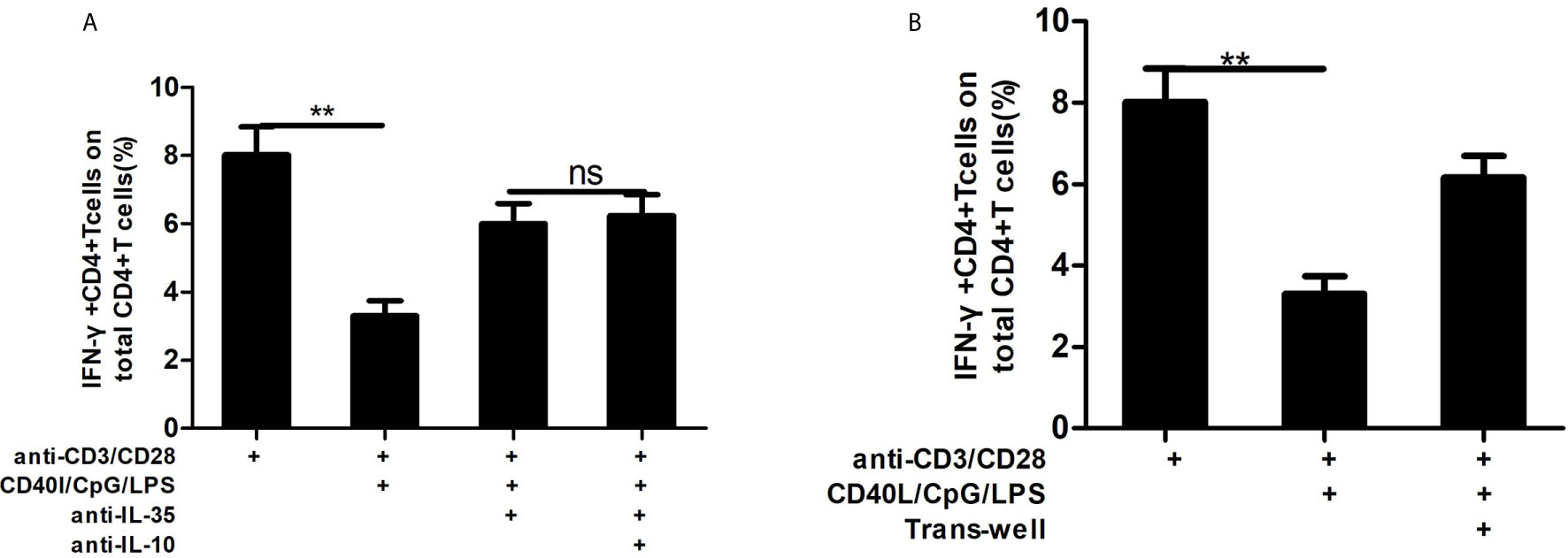
Figure 5 IL-35 neutralizing antibody blocking study and trans-well assay. To explore whether IL-35 worked alone or in collaboration with IL-10 in the process of Bregs regulating on T cell function, neutralizing antibody against IL-35 (1μg/ml, R&D Systems) alone or with neutralizing antibody against IL-10 (5 μg/ml, invitrogen) was added in the co-culture system of anti-CD3/anti-CD28 activated CD19-depleted PBMCs and Bregs. (A) Neutralizing antibody against IL-35 can block suppression function of Bregs on CD4+T cytokine secreting function; (B) Bregs suppressed CD4+T cell cytokine secreting depending on cell-to-cell contact. Non-parametric Kruskal-Wallis ANOVA test and Tukey’s Multiple Comparison test was used to analysis the data. P value<0.05 was considered statistically significant. **p < 0.01. ns, no significant difference.
Bregs, especially B10 cells, are involved in the process of chronic HBV infection, such as CHB (17, 18, 26, 27), HBV-related liver cirrhosis (28), and chronic HBV infection-related renal injury (29) via an IL-10-dependent manner. These findings have prompted studies into the mechanism of B-cell-mediated immune regulation, particularly the suppressive cytokines secreted by B cells. During the process of chronic HBV infection, changes in serum IL-35 levels were observed compared with HCs (21, 30). Shi YY et. al (30). found that in the process of persistent HBV infection, the serum IL-35 levels increased gradually along with disease progression and were positively correlated with the liver inflammation degree. However, Cheng et al. (21) found that serum IL-35 levels were significantly decreased in patients with chronic HBV infection and negatively correlated with serum HBV DNA load and ALT levels. In our previous study (31) and the current research, we confirmed that the serum IL-35 levels in treatment-naïve chronic HBV patients were significantly increased compared with those in HCs, and patients with higher ALT levels (>200 or 300 IU/L) or HBeAg-positive patients had higher serum IL-35 levels. Our findings are consistent with those of Shi et al., suggesting that IL-35 exerts an anti-inflammatory effect during persistent HBV infection. However, the difference between the findings of Cheng et al. (21) and ours suggested that more research is needed to determine the expression and role of IL-35 at different stages of HBV infection.
The role of Bregs in chronic HBV infection was identified by Das et al. (17) in 2012. Since then, several studies have investigated the role of Bregs in chronic HBV infection and HBV infection-related mergers (18, 26, 28, 29). However, these studies only focused on the role of B10 cells. In the present study, we confirmed for the first time that IL-35+B cells were enriched and in parallel with B10 cells in patients with persistent HBV infection. Similar to B10 cells, the frequency of IL-35+B cells was associated with liver inflammation and HBV replication level. These findings suggested that in the process of persistent HBV infection, B cells may exert immune regulation through different pathways. Furthermore, we also confirmed that two typical human Breg subsets (CD19+CD24hiCD38hi and CD19+CD24hiCD27+) were enriched and strongly correlated with the frequency of IL-35+B cells. These results further demonstrated that IL-35+B cells mainly belong to Breg subsets.
Previous studies had demonstrated that Bregs are enriched and exert a regulatory role on multiple immune ECs including T cells in CHB patients (17, 27, 32). These studies showed that Bregs play a regulatory role on HBV-specific T cell responses in an IL-10-dependent manner by inhibiting TNF-α and IFN-γ production and enhancing Treg function. In the present study, we confirmed that Bregs can inhibit IFN-γ production but has little effect on IL-4 production. The inhibitory effect of Bregs on IFN-γ production could be reversed by IL-35 neutralizing antibody in vitro, and the inhibitory effect was dependent on cell-to-cell contact. These results suggest that during HBV infection, Bregs participate in the T cell imbalance regulation process through an IL-35-dependent manner. To our knowledge, this is the first time to determine that that during persistent HBV infection, Bregs exert immune regulation through a channel other than IL-10-dependent pathway. However, in other chronic virus infections, such as HIV infection, Lopez-Abente et al. (33) had confirmed that HIV-1 could induce B cell toward the Breg phenotype and express IL-10, TGF-β, and EBI3 or IL-12(p35) mRNA.
In conclusion, during persistent HBV infection, serum IL-35+B cells exited and was enriched in CD19+CD24hiCD38hi B cell subset. Bregs dysregulated T cell function through an IL-35-dependent mechanism, which depended on cell-to-cell contact.
The original contributions presented in the study are included in the article/Supplementary Material. Further inquiries can be directed to the corresponding author.
The studies involving human participants were reviewed and approved by Clinical Ethics Committees of Shanghai Changhai Hospital. The patients/participants provided their written informed consent to participate in this study.
YYL, YL, TZ, and MJ were involved in recruiting patients, collecting data, and performing a series of in vitro experiments. ZFT and GST assisted the intracellular labeling flow cytometric analysis, and data analysis. YYL, MJ and XSL involved in the study concept and design, and XSL obtained funding. XSL performed the data analysis and drafted the manuscript. All authors contributed to the article and approved the submitted version.
This study was supported by Natural Science Foundation of Shanghai (16ZR1400400; 20ZR1456900) and Wu Jieping Medical Foundation (LSWJPMF-102-17001). Fund units are not involved in the design, analysis and conduct of this study.
The authors declare that the research was conducted in the absence of any commercial or financial relationships that could be construed as a potential conflict of interest.
The authors thank Dr Qian He (Department of Health Statistics, Second Military Medical University) for giving helpful comments in data analysis and confirmation of statistical methods.
The Supplementary Material for this article can be found online at: https://www.frontiersin.org/articles/10.3389/fimmu.2021.653198/full#supplementary-material
1. Terrault NA, Bzowej NH, Chang KM, Hwang JP, Jonas MM, Murad MH, et al. AASLD guidelines for treatment of chronic hepatitis B. Hepatology (2016) 63:261–83. doi: 10.1002/hep.28156
2. Boni C, Fisicaro P, Valdatta C, Amadei B, Di Vincenzo P, Giuberti T, et al. Characterization of hepatitis B virus (HBV)-specific T-cell dysfunction in chronic HBV infection. J Virol (2007) 81:4215–25. doi: 10.1128/JVI.02844-06
3. Wang H, Luo H, Wan X, Fu X, Mao Q, Xiang X, et al. TNF-alpha/IFN-gamma profile of HBV-specific CD4 T cells is associated with liver damage and viral clearance in chronic HBV infection. J Hepatol (2020) 72:45–56. doi: 10.1016/j.jhep.2019.08.024
4. Trehanpati N, Vyas AK. Immune Regulation by T Regulatory Cells in Hepatitis B Virus-Related Inflammation and Cancer. Scand J Immunol (2017) 85:175–81. doi: 10.1111/sji.12524
5. Boni C, Laccabue D, Lampertico P, Giuberti T, Vigano M, Schivazappa S, et al. Restored function of HBV-specific T cells after long-term effective therapy with nucleos(t)ide analogues. Gastroenterology (2012) 143:963–73.e9. doi: 10.1053/j.gastro.2012.07.014
6. Fisicaro P, Valdatta C, Massari M, Loggi E, Biasini E, Sacchelli L, et al. Antiviral intrahepatic T-cell responses can be restored by blocking programmed death-1 pathway in chronic hepatitis B. Gastroenterology (2010) 138:682–93, 693 e1-4. doi: 10.1053/j.gastro.2009.09.052
7. Jiang G, Geng L, Fang Y, Dong S, Xie H, Chen Y, et al. B7-H1 expression is upregulated in peripheral blood CD14tmonocytes of patients with chronic hepatitis B virus infection, which correlates with higher serum IL-10 levels. J Viral Hepat (2006) 13:725–33. doi: 10.1111/j.1365-2893.2006.00746.x
8. Wherry EJ, Barber DL, Masopust D, Zhu B, Allison JP, Sharpe AH, et al. Restoring function in exhausted CD8 T cells during chronic viral infection. Nature (2006) 439:682–7. doi: 10.1038/nature04444
9. van der.Molen RG, Stoop JN, Baan CC, van der Laan LJ, Kuipers EJ, Kusters JG, et al. Regulatory T cells contribute to the impaired immune response in patients with chronic hepatitis B virus infection. Hepatology (2005) 41:771–8. doi: 10.1002/hep.20649
10. Fu J, Xu D, Jin L, Zhang H, Zhou C, Zou Z, et al. Circulating and liver resident CD4+CD25T regulatory T cells actively influence the antiviral immune response and disease progression in patients with hepatitis B. J Immunol (2006) 177:739–47. doi: 10.4049/jimmunol.177.1.739
11. Demircik F, Madan R, Surianarayanan S, Allen JL, Divanovic S, Trompette A, et al. Nonredundant roles for B cell-derived IL-10 in immune counter-regulation. J Immunol (2009) 183(4):2312–20. doi: 10.4049/jimmunol.0900185
12. Hauyon-La Torre Y, Ronet C, Revaz-Breton M, Mastelic B, Tacchini-Cottier F, Louis J, et al. Regulatory B cells shape the development of Th2 immune responses in BALB/c mice infected with Leishmania major through IL-10 production. J Immunol (2010) 184(2):886–94. doi: 10.4049/jimmunol.0901114
13. Ogawa A, Sugimoto K, Shimomura Y, Nagahama K, Mizoguchi A, Bhan AK. Inducible IL-12-producing B cells regulate Th2-mediated intestinal inflammation. Gastroenterology (2007) 133(1):124–36. doi: 10.1053/j.gastro.2007.03.112
14. Sweenie CH, Fillatreau S, McGeachy MJ, Gray D, Anderton SM. B cells regulate autoimmunity by provision of IL-10. Nat Immunol (2002) 3(10):944–50. doi: 10.1038/ni833
15. Miyagaki T, Yoshizaki A, DiLillo DJ, Matsushita T, Horikawa M, Kountikov EI, et al. Regulatory B Cells Control T Cell Autoimmunity Through IL-21-Dependent Cognate Interactions. Nature (2012) 491(7423):264–8. doi: 10.1038/nature11501
16. Damdinsuren B, Olkhanud PB, Bodogai M, Gress RE, Sen R, Wejksza K, et al. Tumor-evoked regulatory B cels promote breast cancer metastasis by converting resting CD4 T cels to T-regulatory celsJ. Cancer Res (2011) 71(10):3505–15. doi: 10.1158/0008-5472.CAN-10-4316
17. Ellis G, Das A, Pallant C, Lopes AR, Khanna P, Peppa D, et al. IL-10 producing regulatory B cells in the pathogenesis of chronic HBV infection. J Immunol (2012) 189(8):3925–35. doi: 10.4049/jimmunol.1103139
18. Gong Y, Zhao C, Zhao P, Wang M, Zhou G, Han F, et al. Role of IL-10-Producing Regulatory B Cells in Chronic Hepatitis B Virus Infection. Digest Dis Sci (2015) 60:1308–14. doi: 10.1007/s10620-014-3358-1
19. Li X, Tian L, Dong Y, Zhu Q, Wang Y, Han W, et al. IL-35 inhibits HBV antigen-specific IFN-γ-producing CTLs in vitro. Clin Sci (2015) 129:395–404. doi: 10.1042/CS20140511
20. Yang L, Jia S, Shao X, Liu S, Zhang Q, Song J, et al. Interleukin-35 modulates the balance between viral specific CD4(+)CD25(+)CD127(dim/-) regulatory T cells and T helper 17 cells in chronic hepatitis B virus infection. Virol J (2019) 16:48. doi: 10.1186/s12985-019-1158-0
21. Cheng ST, Yuan D, Liu Y, Huang Y, Chen X, Yu HB, et al. Interleukin-35 Level Is Elevated in Patients with Chronic Hepatitis B Virus Infection. Int J Med Sci (2018) 15:188–94. doi: 10.7150/ijms.21957
22. Shen P, Roch T, Lampropoulou V, O’Connor RA, Stervbo U, Hilgenberg E, et al. IL-35-producing B cells are critical regulators of immunity during autoimmune and infectious diseases. Nature (2014) 507:366–70. doi: 10.1038/nature12979
23. Dang VD, Hilgenberg E, Ries S, Shen P, Fillatreau S. From the regulatory functions of B cells to the identification of cytokine-producing plasma cell subsets. Curr Opin Immunol (2014) 28:77–83. doi: 10.1016/j.coi.2014.02.009
24. Egwuagu CE, Yu CR. Interleukin 35–Producing B Cells (i35-Breg): A New Mediator of Regulatory B-Cell Functions in CNS Autoimmune Diseases. Crit Reviews™ Immunol (2015) 35:49–57. doi: 10.1615/CritRevImmunol.2015012558
25. Bouaziz JD, Calbo S, Maho-Vaillant M, Saussine A, Bagot M, Musette P, et al. IL-10 produced by activated human B cells regulates CD4(+) T-cell activation in vitro. Eur J Immunol (2010) 40:2686–91. doi: 10.1002/eji.201040673
26. Liu Y, Cheng LS, Wu SD, Wang SQ, Li L, She WM, et al. IL-10-producing regulatory B-cells suppressed effector T-cells but enhanced regulatory T-cells in chronic HBV infection. Clin Sci (Lond) (2016) 130:907–19. doi: 10.1042/CS20160069
27. Wang G, Liu Y, Huang R, Jia B, Su R, Sun Z, et al. Characteristics of regulatory B cells in patients with chronic hepatitis B virus infection in different immune phases. Discovery Med (2017) 23:295–304.
28. Xiong Y, Wu H, Li Y, Huang R, Liu Y, Chen Y, et al. Characteristics of peripheral and intrahepatic regulatory B cells in HBV-related liver cirrhosis. Int J Clin Exp Pathol (2018) 11:4545–54.
29. Liu Y, Wang H, Hu X, Qu Z, Zhang H, Crew R, et al. A higher frequency of IL-10-producing B cells in Hepatitis B virus-associated membranous nephropathy. Clin Exp Pharmacol Physiol (2016) 43:417–27. doi: 10.1111/1440-1681.12552
30. Shi YY, Dai MJ, Wu GP, Zhou PP, Fang Y, Yan XB. Levels of interleukin-35 and its relationship with regulatory T-cells in chronic hepatitis B patients. Viral Immunol (2015) 28:93–100. doi: 10.1089/vim.2014.0058
31. YaYun L, Jiao Y, Yang Y, Meng J, ChengZhong L, XueSong L. Expression and role of interleukin 35-producing B cells and interleukin 35 from peripheral blood of patients with chronic hepatitis B. Chin J Infect Dis (2017) 35:528–32. doi: 10.3760/cma.j.issn.100006680.2017.09.003
32. Mauri C, Bosma A. Immune regulatory function of B cells. Annu Rev Immunol (2012) 30:221–41. doi: 10.1146/annurev-immunol-020711-074934
Keywords: chronic HBV infection, regulatory B cells (Bregs), interleukin 35 (IL-35), IL-35-secreting B (IL-35+B) cells, HBV - hepatitis B virus, immune regulation
Citation: Liu YY, Luo Y, Zhu T, Jiang M, Tian Z, Tang GS and Liang XS (2021) Regulatory B Cells Dysregulated T Cell Function in an IL-35-Dependent Way in Patients With Chronic Hepatitis B. Front. Immunol. 12:653198. doi: 10.3389/fimmu.2021.653198
Received: 14 January 2021; Accepted: 23 March 2021;
Published: 12 April 2021.
Edited by:
Bruce Milne Hall, University of New South Wales, AustraliaReviewed by:
Ciriana Orabona, University of Perugia, ItalyCopyright © 2021 Liu, Luo, Zhu, Jiang, Tian, Tang and Liang. This is an open-access article distributed under the terms of the Creative Commons Attribution License (CC BY). The use, distribution or reproduction in other forums is permitted, provided the original author(s) and the copyright owner(s) are credited and that the original publication in this journal is cited, in accordance with accepted academic practice. No use, distribution or reproduction is permitted which does not comply with these terms.
*Correspondence: Xuesong Liang, TGlhbmd4dWVzb25nMjAwMEAxNjMuY29t; GuSheng Tang, ZHJha2UwMTVAMTYzLmNvbQ==
†These authors share first authorship
Disclaimer: All claims expressed in this article are solely those of the authors and do not necessarily represent those of their affiliated organizations, or those of the publisher, the editors and the reviewers. Any product that may be evaluated in this article or claim that may be made by its manufacturer is not guaranteed or endorsed by the publisher.
Research integrity at Frontiers

Learn more about the work of our research integrity team to safeguard the quality of each article we publish.